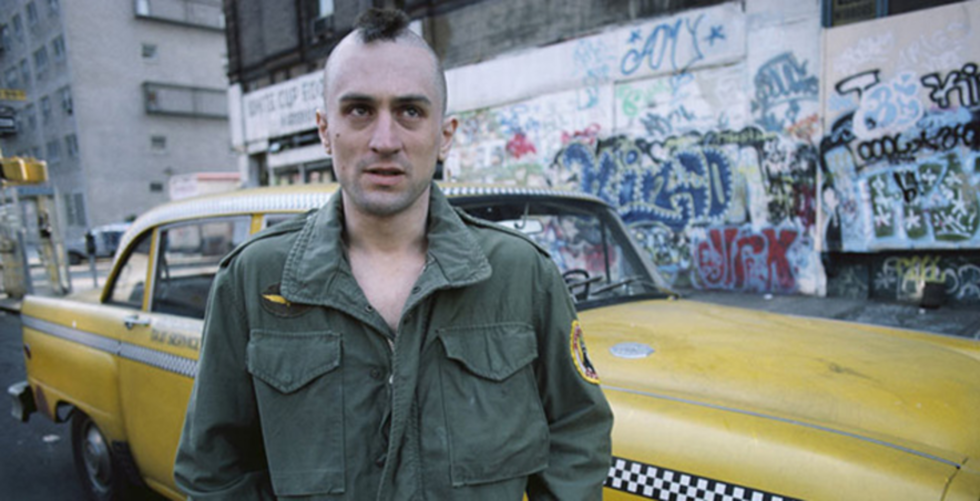
BY PETER GUTIÉRREZ |
Taxi Driver: The Final Noir
Don’t look now, but this month marks 35 years since the release of Martin Scorsese’s Taxi Driver… and the end of film noir as audiences had come to know it.


It sneaks up on you so quietly that you’ll be forgiven not noticing when it finally arrives—that moment when Taxi Driver takes its place alongside the other landmarks in the rich history of film noir. Of course evidence for this assessment can be found throughout the film, but everything really comes together in that understated bit of voice-over that occurs at the start of the third act: “Loneliness has followed me my whole life, everywhere. In bars, in cars, sidewalks, stores. Everywhere. There’s no escape.”
We hear these words, delivered with a sigh poised on the brink of heartbreak, as the camera glides slowly past crowds and couples that are close enough to touch and yet remain impossibly remote. In this brief scene the sadness of urban life itself seems to crystallize, that core loneliness that can lead to acts desperate, redemptive, or both. After this point, it’s hard not to sense that, in addition to being daring and spectacularly accomplished, Martin Scorsese’s 1976 film also represents a deeply felt extension of the enduring poetry of film noir. What might be harder to notice at first blush is that it’s also a sorry-to-break-the-news-to-you rebuttal of the genre’s most cherished truths.
To contend that Taxi Driver marks an important if informal “end” to noir as it been practiced over the previous decades is not to speak in historical terms. After all, classic noir had started to peter out by the early ’60s, and certainly the years since ’76 have seen many notable neo-noirs and retro-noirs. Yet with the appearance of Taxi Driver, the soul of noir would never quite be the same, and thus it signals a closing chapter of sorts. More of a farewell to the tradition than an attack on it, the film is a break-up letter penned tinged with sadness but no bitterness. It’s not that there haven’t been good times, it seems to say. It’s just that by the mid-’70s, life in the big city had changed such that the same shadows shot in the same seductive ways just wouldn’t cut it anymore. So by consistently inverting the genre's tropes, or by taking them to frightening extremes, Scorsese and company both showed affection for the classics of an earlier era and demonstrated that their bleak yet oddly romantic view of urban life was no longer adequate for capturing the realities of the post-Vietnam period.
Indeed, in both conception and construction, Taxi Driver implicitly challenges the ideological, psychological and narrative strategies upon which noir had built an international rep. Yet that doesn’t mean it necessarily refutes noir’s assumptions about the world; more precisely, the film questions its artistic responses to those assumptions. For example, this story of a homicidal cabbie definitely posits that cities are dangerous and predatory, but also suggests that the resultant violence is more likely to manifest as crimson-drenched gore than as monochromatic blood bathed in stylish chiaroscuro. For film noir to be emotionally, and yes, spiritually honest, Taxi Driver maintains that it must show ugliness for what it is—that is, not transfigure it into the picturesque, but present it as truly menacing and dirty.

Similarly, Taxi Driver takes on the femme fatale archetype head-on by, quite startlingly, deciding not to include one. The title character’s disastrous courting of Betsy (Cybill Shepherd), the placed-on-a-pedestal campaign worker, leads to the typical lone wolf renunciation of all mushy feelings, and in this case triggers his downward spiral as well. She is pronounced “cold and distant,” and, more tellingly “like all the others.” The problem is that we know Betsy to be the opposite, surprisingly warm and receptive to his advances, even to the point where she follows him into a porno theater, a venue that he sees as a valid dating option much like you or I would view the neighborhood multiplex. Yes, men who fail with the women they desire often react in ways that sublimate their sexual frustration/humiliation—but they don’t do so because such women are invariably devious temptresses.
Yet for all its tweaks of traditional noir, Taxi Driver is rife with formal and thematic elements that indicate its abiding respect for the genre. The sax line from Bernard Herrmann’s gorgeously sorrowful—and hauntingly anachronistic—main theme comes to mind. So too the film’s hardboiled dialogue, war veteran protagonist, engaging voice-over, endless asphalt, and highly evocative location shooting. These kinds of scrupulous quotes of older films recall the more overtly noirish Chinatown, which had won an Oscar the previous year. However, when Roman Polanksi and Robert Towne show how all the wisecracks and resourcefulness a private eye can muster are ultimately ineffectual in the face of true corruptive evil, the message is quite different. As Chinatown’s final line despairingly suggests, attempts to do the right thing are usually better not made: redemption is a lot more difficult than the movies make it seem. Taxi Driver, by contrast, actually does provide that redemption… but also presents it as arbitrary, possibly meaningless, and certainly psychotic.

We don’t know much about our would-be hero, Travis Bickle. In his brilliant novel Suspects, which imagines the secret histories of noir characters, David Thomson depicts him as one of George Bailey’s kids from It’s a Wonderful Life. As Robert De Niro plays him, with his vestigial hint of Middle American good manners and apparently innate disdain of New York, there’s nothing to suggest that this couldn’t be true. So how does nocturnal yet unassuming Travis morph into an aspiring assassin who’s armed to the teeth and then some?
Geography, as it turns out, may be the least of the contributing factors. History is probably a better place to look. By the time the 1970s roll around, it’s pretty clear we’re all small-time hustlers. Want a chunk of Errol Flynn’s bathtub to sell on commission? Well, one of your cabbie buddies can help you out there. Want any of your outré personal desires fulfilled? Just say the word. Significantly, both Jodie Foster’s tween prostitute and Taxi Driver’s gun-and drug-pushing “traveling salesman” go by the name “Easy.” That’s how simple it is to head down the path of depravity and murder. And who’s to stop you? As Travis points out, the cops aren’t enforcers of morality in any sense.


What about political leaders, then? The trouble here is that the film’s would-be savior of the common man, presidential candidate Charles Pallantine (Leonard Harris), is basically portrayed as no more than a smooth talker—a seducer with words not too distant from Harvey Keitel’s pimp character. Sure, the slimy pol was hardly a new invention, but never before had killing one seemed like a viable option for what was ostensibly a sympathetic character. What had changed in American culture to make this possible? Well, maybe we should remember that a couple of years earlier, a sitting president had resigned in the aftermath of a clumsy B&E.
Pallantine’s crime, though, is nothing so blatant. Instead, he manipulatively leverages contemporary anxieties for personal gain. Witness his glibly populist talking points: “We the people suffered in Vietnam. We the people still suffer from unemployment, inflation, crime, and corruption.” Thus the script pretty much itemizes ’70s malaise, handily outlining the historical moment but not providing a character who can actually address any of these issues, even if only on a local or personal scale. In other words, if the audience is searching for any real heroes, it best look elsewhere.
This brand of cynicism is not incongruent with traditional noir. Indeed, the genre’s protagonists are just as often anti-heroes as heroes, and what’s compelling is the way they walk the line between the two categories, often making us doubt whether there’s any essential difference between them. Although these characters are typically cops, crooks, or private eyes, they can also be drifters, prizefighters, reporters or working stiffs. The common ground in all these cases is that their ultimate status as good guy or seedy operator seems to be determined by how they respond to a central challenge that fate places in their way. Can they overcome their own greed, sleaziness, or moral inertia to achieve some kind of symbolic victory, even if it’s pyrrhic in nature?

Certainly Travis thinks he’s embarking on such a quest when he undertakes his new regimen of morning push-ups and afternoon gunsmithing. Yet here Taxi Driver brilliantly critiques the spirit of the times by presenting a nightmarish take on the Me Decade’s penchant for self-improvement. Just compare two of the more famous “training” sequences in American movie history: Travis’s and Rocky Balboa’s in the film that ended up winning the Oscar over Taxi Driver. Rocky jogs up steps in an affirmation of upward mobility while Travis holds his fist over an open flame, suggesting that the purging of impurity can only be achieved through sacrifice that is almost too painful to endure.
To be sure, redemption in noir always comes with a price—sometimes, the ultimate one. And in fact, Travis does plan on dying as a result of assassinating Pallantine, and he explicitly communicates this to Iris (Foster) in his goodbye note. Then, at the close of the film’s bloody climax, he makes a point of trying to kill himself. The fact that he does not perish, though, that nothing of value is sacrificed, is where Taxi Driver is most radically iconoclastic. Whether the epilogue is really a dispatch from a coma-bound Travis is a topic to address elsewhere, but in its surface narrative it demonstrates that redemption with all the trimmings is clearly possible—but in a way that renders the term meaningless. When Cybill Shepherd in Lizbeth Scott-mode stops just short of apologizing to Travis in the final scene, we’re heading into territory where fantasy trumps reality. Moreover, Travis’s act of “heroism” is almost accidental—his rescuing of Iris is a hastily conceived Plan B after botching the assassination attempt. Once the moral compass is so corroded, Taxi Driver contends, the blood that boils in a man seeks a target, and this is just as likely to be one that’s “deserving” of death as not.

Of course it’s from its strikingly ambivalent ending that Taxi Driver gains so much of its power. Travis is publicly lauded as a hero, but we know better, and so the way that the film exploits the subtle yet inherent contradictions of noir is dead-on: he never fully confronts his demons or pays any lasting price (except for “a little stiffness” in his neck) and yet feels redeemed nonetheless. One reason that old-school noir remains so attractive to audiences is the way it reaches an artful compromise between cynicism and idealism. Many of its most memorable examples neither shy away from depicting a world suffused with untempered brutality and sexual anguish nor hesitate in comforting us by positing the possibility, albeit bittersweet, of attaining wisdom, if not outright salvation.
The beauty of Taxi Driver is that it keeps us fans of noir honest by illustrating that even dreams of redemption must be critically examined lest they breed monsters. As such, it’s a fitting elegy for the genre.
If you haven't seen Taxi Driver in a while, we're sure you'll want to revisit it now. To satisfy an instant craving, watch it on demand via Amazon. An even better idea: buy the 2-disc collectors' edition from Sony Pictures. If you have a little more patience, you can rent it from Netflix.
Oh, and it's having a 2-week run at Film Forum, March 18-31. It's a newly restored 35mm print, so don't miss it on the big screen!
Want more noir? Check out For the Love of Film [Noir]: The Film Preservation Blogathon. Become a fan on Facebook, and donate today!
Want more? Here's the original trailer from 1976: